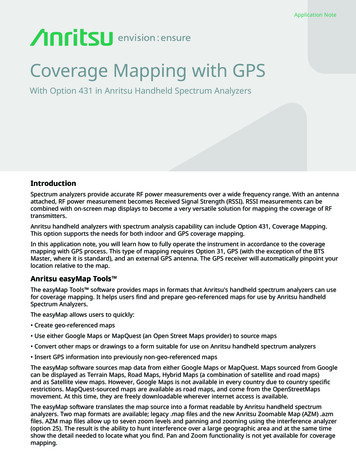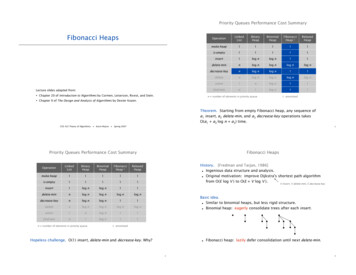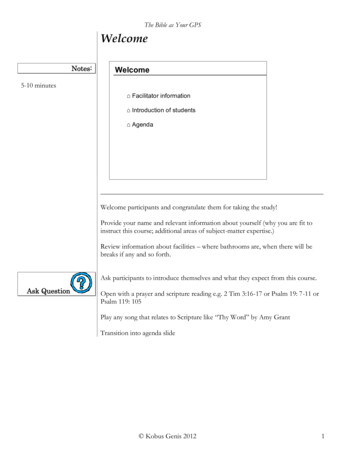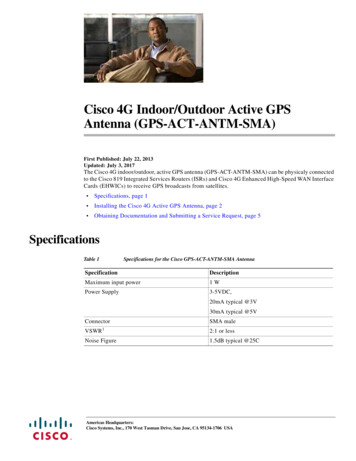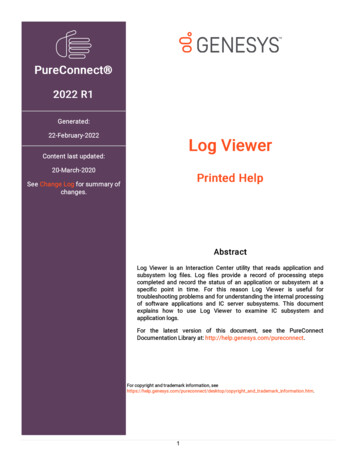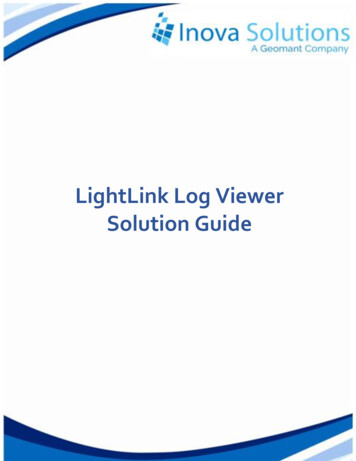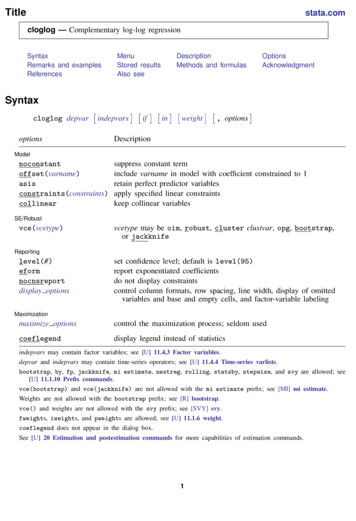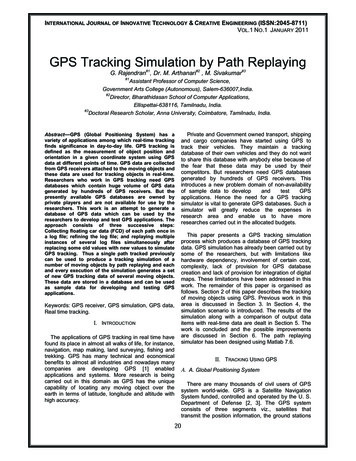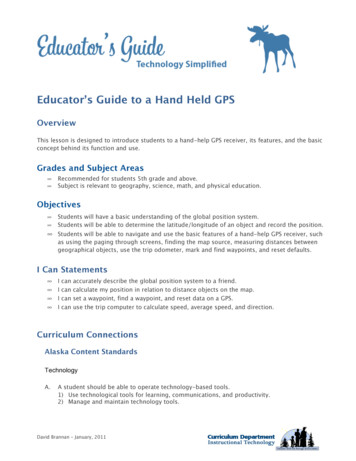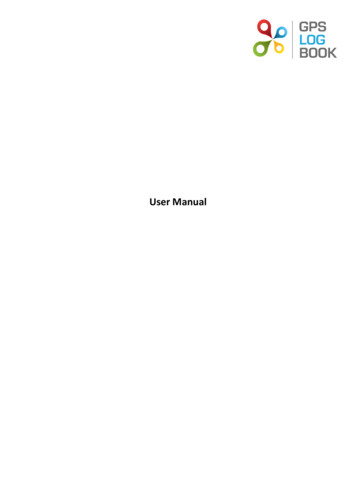
Transcription
User Manual
Table of Contents12Introduction . 31.1Who can benefit from keeping an accurate Log Book .31.2Key Features of GPS Log Book .3GPS Log Book Classic . 42.1In the box .42.2Technical Specifications .42.3Requirements ines on how to use the GPS Log Book device . 4LED Information . 5Getting Started .5Download the GPS Log Book Sync Application . 5Plugging your device into the computer for the first time. 6Upload Data from the GPS Log Book Device . 103.1In the box . 103.2Technical Specifications . 103.3Requirements . 103.43.4.13.5Minimum PC Requirements . 10Using the Device . 11Guidelines on how to use the GPS Log Book LiVE device. 11Getting Started . 11Managing Trip Data .34.3.14.3.24.3.34.3.44.3.55Using the Device .4GPS Log Book LiVE .103.3.14Minimum PC Requirements . 4Supported web browsers include . 4Trips Page . 12Create and Edit Zones . 12Change designation of a trip . 13View Trip detail . 13Add a comment about a specific trip . 14Snap To Zone . 14Selected Zone . 14Trip Categorization (Pro Account Only). 14Zones Page . 16Create a New Zone . 16Reports . 17Business Travel Clam Report . 17Business Travel Report . 18Trip List for All Vehicles in PDF or CSV . 18Weekly Mileage Comparison . 18Zone Detailed Report . 18Manage Logbooks .20GPS Log Book – User Manualwww.gpslogbook.comPage 1 of 26
5.1Capture Odometer Reading (2). 205.2Add Logbook (3) . 205.3Capture Expense (4) . 216Managing the Account .216.1Update Account Details . 216.1.16.1.26.1.36.1.47Edit Personal Details . 21Change Password . 21Settings . 21Personal Selection . 22Managing Vehicles & Devices .227.1Device Details . 227.1.17.1.2Device Parameters . 23Attaching a vehicle to a device. 237.2Vehicle Details . 237.3Add Additional Vehicles . 238Mobile Application .259Recommendations .269.1Upload Data Every Two Weeks. 269.2Update Vehicle Information . 2610Frequently Asked Questions .26GPS Log Book – User Manualwww.gpslogbook.comPage 2 of 26
1IntroductionMaintaining an accurate log book can be a tedious affair. The GPS Log Book is a simple device that, together with an online system, greatlysimplifies and assists this process. The benefits of the additional tax savings make it a very worthwhile device to own.Keeping an accurate log book of business and personal travel is not only required as a legal prerequisite by the South African Revenue Service(SARS) if travel expenses are to be claimed, it also allows claims to be based on the actual distances travelled. Without a Log book it would not bepossible to claim for travel deductions.1.1Who can benefit from keeping an accurate Log Book 1.2Sole proprietors, commission earnersEmployees who receive a travel allowanceEmployees, directors, members who use a company owned vehicleEmployers managing a small fleet of vehicles and drivers – Also ask us about the corporate interface!Key Features of GPS Log Book User friendly and well-designed online systemSARS ComplianceGoogle Maps used to display tripsCustomisation of start and end points (zones) specific to any tripOne year warranty period from date of purchaseEasy to add new vehiclesEasy to use on different computersAmple storage capacityFrequent recording interval on the deviceNo annual or monthly subscription fees are associated with the basic GPS Log Book service. Additional fees applicable to value-addedservicesGPS Log Book – User Manualwww.gpslogbook.comPage 3 of 26
2GPS Log Book Classic2.1In the boxWhen receiving the GPS Log book, the following items will be found in the box: 2.2GPS Log Book deviceIllustrated quick start guideUSB CableTechnical Specifications2.3ComponentRatingAssisted GPSHigh sensitivity 50 Channel GPS with a maximum accuracy of 2.5mPower supply (input voltage range)8V - 30V DC with transient protection. Internally fused at 8A.Power supply (average current draw)Approximately 45mA acquiring, 35-40mA trackingUSB Charger5V, max 1A continuousUSB interface to PCHID (Human Interface Device) via a USB Mini-B cable.Super capacitorSufficient charge to hold the GPS time and data for 8 hours.Internal Flash Memory4Mbytes total, 3.6Mbytes for trip data.Metal componentsNickel plated mild and spring steelPlasticABS PlasticLEDTri colourOperating temperature-10 to 60 degrees C with 0.5A charging loadDimensions102mm x 41mm x 22mmRequirements2.3.1Minimum PC RequirementsThe minimum requirements for running the software required to operate the GPS Log Book are listed below: 2.3.2 2.4Microsoft Windows 7 / Vista / XP SP2MAC OS X 10.4 or laterInternet Connectivity1 x USB portSupported web browsers includeMicrosoft IE8 or greaterMozilla FirefoxGoogle ChromeUsing the Device2.4.1Guidelines on how to use the GPS Log Book deviceOnce the GPS Log Book device has been removed from the packaging, it is ready to start recording the first trip: Plug the device into the 12V outlet / cigarette lighter of the vehicle.Turn the ignition of the vehicle on.GPS Log Book – User Manualwww.gpslogbook.comPage 4 of 26
The LED will be solid red – this indicates that the device has not yet found its position and is searching for satellites.The LED will turn green – this indicates that the device has found its location and tracking is in progress.The vehicle can now be driven and the GPS Log Book device will record the trip.Remove the device at any stage to stop the recording.NOTE:The device will end a trip when it loses power. Some vehicles’ 12V outlet / cigarette lighter do not switch off when the ignition is turned off. Inthese cases the device will stop recording data and go into a low power mode when the vehicle does not move for 5 minutes.2.4.2LED InformationRedGreenFlashing RedThe log book has power and is searching for satellitesThe log book has found satellites and is loggingThe log book is 80% full and will need to be connected to the server soon to upload the data (seebelow).NOTE: 2.5If the solid Red does not turn Green then the device is unable to find any satellites (e.g. if the vehicle is parked in a basement) and nodata will be recorded.It is recommended that the device is synchronised at least every 11 to 14 days. This will ensure optimal GPS performance is maintained.The log book will find satellites faster if it has valid aiding data. Roughly speaking, aiding data gives the GPS an idea of where to startlooking for satellites and hence helps it to find its location faster. This data will be loaded onto the device almost every time it isconnected to the computer, and is valid for 14 days.Getting Started2.5.1Download the GPS Log Book Sync ApplicationThe Sync Application is the application used to read data off the device and send it to the GPS Log Book server for processing and storing.Download and install this application before connecting the GPS Log Book device to your computer/laptop for the first time1.Navigate to the Downloads page of the GPS Log Book website www.gpslogbook.co.za/downloads2.3.Ensure that the system requirements of the computer or laptop in use, meet those listed on the page.Click on the relevant download icon.GPS Log Book – User Manualwww.gpslogbook.comPage 5 of 26
In the case of a computer running Microsoft Windows, the following steps are applicable.4.5.6.7.If anti-virus software is installed on the computer, it may ask for confirmation that the download is allowed.Once the file is downloaded, start the installation by running the downloaded file.The GPS Log Book Sync Setup Wizard will open in a new window, and the installation will begin immediately. Please wait while the filesare installed.When the installation is complete click on Finish to end the Sync App installation process.Now you are ready to connect your device for the first time.2.5.2Plugging your device into the computer for the first timeThe first time the device is connected to the computer, the computer will attempt to install a driver. The Sync Application will then run,communicate with the server, and automatically load the Register Device page on the website in order to capture details that will be associatedwith that specific GPS Log Book device.1.2.Connect the GPS Log Book device to the computer using the USB cable provided.The computer will install the device driver software. Please wait for this to complete.3.4.Once the driver has installed, the Sync Application will automatically load the Register Device page.The website will open in your browser and you will be asked to either register a new account or use an existing account.GPS Log Book – User Manualwww.gpslogbook.comPage 6 of 26
5.If you have not setup an account before, select “Register a new account” and click the continue button. If you have already registered anaccount go to step 6.5.1. You will be asked to give some personal details.GPS Log Book – User Manualwww.gpslogbook.comPage 7 of 26
5.2. Once you click register your will see the page below. You can close this window and wait for your account validation email.5.3. Once you receive your account validation email, click on the first link to validate your email address.6.7.If you already have an account, fill in your login details and click on the Register button. (If you performed step 5, skip this step)You will now see the Register Device page like the picture below.GPS Log Book – User Manualwww.gpslogbook.comPage 8 of 26
7.1. You can now give your device a name, select an existing vehicle or create a new one, and enter the optional tax details.7.2. Click the Continue button to complete the process.GPS Log Book – User Manualwww.gpslogbook.comPage 9 of 26
2.5.3Upload Data from the GPS Log Book DeviceAfter successfully creating an account and registering your device, you are ready to upload trip data to the website.1.2.3.4.3Connect the GPS Log Book device to the computer using the USB cable provided.The Sync Application will automatically download any trip data from the device and upload it to the GPS Log Book server.The LED on the device will turn Red while data transfer is in progress.Once all the data has been downloaded from the device and new aiding data downloaded to the device, a message will be displayedstating that it is safe to disconnect the device and the LED on the device will turn Blue.GPS Log Book LiVE3.1In the boxWhen receiving the GPS Log Book LiVE, the following items will be found in the box: 3.23.3GPS Log Book LiVE deviceRegistration pamphlet with serial number and registration PINFuse kitInstallation pamphlet with wiring diagramTechnical SpecificationsComponentRatingAssisted GPSHigh sensitivity 50 Channel GPS with a maximum accuracy of 2.5mPower supply (input voltage range)8V - 30V DC with transient protection. Internally fused at 8A.Power supply (average current draw)Approximately 45mA acquiring, 35-40mA trackingInternal Flash Memory4Mbytes total, 3.6Mbytes for trip data.PlasticABS PlasticOperating temperature-10 to 60 degrees C with 0.5A charging loadDimensions126mm x 90mm x 25mmRequirements3.3.1Minimum PC RequirementsThis device does not require special software. The only requirement is an internet connection and one of these supported browsers:GPS Log Book – User Manualwww.gpslogbook.comPage 10 of 26
3.4Microsoft IE8 or greaterMozilla FirefoxGoogle ChromeUsing the Device3.4.1Guidelines on how to use the GPS Log Book LiVE deviceOnce the GPS Log Book device has been removed from the packaging, it is ready to start recording the first trip: Plug the device into the 12V outlet / cigarette lighter of the vehicle or connect directly to the vehicle’s power using the included fuse kit.The vehicle can now be driven and the GPS Log Book device will record the trip.There is no need to remove the device from your vehicle.NOTE:The device’s internal battery may take some time to charge when initially connected.3.5Getting StartedYou need to register yourself and your device on the GPS Log Book website before the device can start reporting its activity.1.2.With your registration pamphlet ready, browse to http://www.gpslogbook.co.za/registerliveYou will see the screen pictured below. If you already have a GPS Log Book account select Existing Account and use your details to log in.Otherwise select Register New Account and click continue and follow steps 5 from the previous section.3.Enter device details3.1. From the registration pamphlet enter the device serial number, registration PIN and a device name.3.2. Select an existing vehicle or create a new one.3.3. Click ContinueGPS Log Book – User Manualwww.gpslogbook.comPage 11 of 26
4.Next you will be asked to sign up for a subscription. Follow the prompts and away you go.44.1Managing Trip DataTrips PageThe GPS Log Book system will display all the trips for a specific vehicle. The account user has the ability to perform the following functions underthe Trips section:4.1.1Create and Edit ZonesGPS Log Book – User Manualwww.gpslogbook.comPage 12 of 26
The zone is the area in which any given trip starts or ends. If it is the first time you view your trips all the zones will be labelled “Unknown” (1 inpicture above). To create a zone at that point, click on the “Unknown”. You will then be presented with the “Create new zone” dialog.The default zone radius is set to 100m. This can be changed at any stage and may be increased to a maximum of 500m and minimum of 0m. Thezone radius is the area directly surrounding the point at which the trip started or ended. You can also change the zone to be a polygon or shapeinstead of a circle, by clicking on the “Replace the zone circle with a shape” link. If you click the “Location Look-up” link, the web page will attemptto get the closest street address from Google Maps and display it in the Comment box.You can at any time change any of the information about the zone, including in the shape and size of the zone, by clicking on the name of the zonein the trip table and clicking the “Edit this zone” link.Click Save when you are done with creating or editing the zone. To undo the changes click on the cross in the top right-hand corner of the dialogbox.Once you have created or edited a zone, all the trips will be reprocessed and the new zone will be applied to the trips.The trip table will be updateto reflect the change.4.1.2Change designation of a tripThere are only two types of designation for a trip, business or private. It is important to indicate all business trips when claiming for businessmileage in a tax return. To change the designation of a trip, click on the icon adjacent to the trip (2 in picture above) and it will change frompersonal (a picture of a house) to business (a picture of a briefcase) or vice versa. The designation can also be changed in the View Trip screen.4.1.3View Trip detailGPS Log Book – User Manualwww.gpslogbook.comPage 13 of 26
To view the detail of a trip, click on View in the trip table (3 in picture above). The trip will be displayed on a map showing the trip in red. The tripcan then have a comment added, or can be deleted. It is also possible to move to the next or previous trip from this view. Any changes made tothe trip will be saved when you close the dialog or click the next or previous button. You must undo the changes manually if you don’t want tokeep them.4.1.4Add a comment about a specific tripTo add a comment to a trip, click on the comment field (4 in picture above) in the table or click on view.4.1.5Snap To ZoneWhen a trip starts or ends within the snapping distance of a specific zone, that zone will automatically be selected. The zone selected will bereferred to as a Snapped Zone. These zones will have an asterisk (*) next to them on the Trip Table.4.1.6Selected ZoneIf a starting or end point cannot be ‘snapped’ to a nearby zone, it is then possible to select an existing zone. Select the zone to be edited and thenselect the nearby zone from the drop down list provided. The assigned zone is referred to as a Selected Zone and will be marked with a tilde ( )next to the zone name on the Trip Table.4.1.7Trip Categorization (Pro Account Only)Trip categorization adds a second level to trip designation and greater control over trip grouping/filtering in reports. A category can be assignedacross designations (i.e. a category can be assigned to private and business trips). Six default categories are created. The label of a category can beedited but the colour cannot be changed. To enable automatic categorization of trips at upload, a zone can be assigned a category. A trip will beassigned the category of its end zone.To edit the category of a trip: In the table view: Click on the square in the left-most column. This will open a menu with the available categories. Select the desiredcategory.GPS Log Book – User Manualwww.gpslogbook.comPage 14 of 26
In the Trip detail view: Click on the coloured square or the category label to open the menu.The Category MenuCategory MenuEdit Category Labels dialog boxThe currently assigned category will be wider than the rest, as is the case with the “Orange” category in the above picture.To edit the category labels, open the category menu as explained above and click the “Edit” option. This will open the “Edit CategoryLabels” dialog box. Edit the desired label and click Save. If you do not wish to change any labels close the dialog box by clicking on thecross in the top right-hand corner.GPS Log Book – User Manualwww.gpslogbook.comPage 15 of 26
4.2Zones PageThe Zone Table contains all zones that have been created. The zones can be edited or deleted from this table. It is also possible to add a commentor change the designation of the zone from this page.4.2.1Create a New ZoneTo create a new zone, click on the Create New Zone button on the Zones page. A dialog will be displayed with a map of the world and a textbox toenter an address. Once the specific location on the map where the zone is to be created has been found using the Google Maps controls, the pincan be dragged to the relevant area, or the outline of the area defined. The zone can be named, and the correct designation selected. The newzone will then be added to the Zone Table.GPS Log Book – User Manualwww.gpslogbook.comPage 16 of 26
4.3ReportsThere are five of reports that are available on the GPS Log Book website. These can be found under the Reports tab.4.3.1Business Travel Clam ReportThis report can be used to claim for business mileage. Only trips that have been marked as business under the ‘My Trips’ page, will appear on thisreport.GPS Log Book – User Manualwww.gpslogbook.comPage 17 of 26
4.3.2Business Travel Report4.3.3Trip List for All Vehicles in PDF or CSVThis report lists every trip for every vehicle linked to the account, within the selected date range. Trips are grouped by vehicle and designation(private or business).This report uses the same interface and parameters as Business Travel ReportThe CSV version of this report offers some extra information: GPS Co-ordinates for trip start and end locationRunning cost if a Cost per Km value was suppliedApproximate stop duration if the end and start zone of consecutive trips are the same.This report is ordered by trip start date and time. It is exported as a csv file that can be viewed with any spread sheet editing software, such asExcel4.3.4Weekly Mileage ComparisonThis report shows a bar graph of business vs private trips for a vehicle, summed over a week.This report uses the same interface and parameters as Business Travel Report4.3.5Zone Detailed ReportThe Zone Detailed Report shows all the trips that have been made to and/or from a specific zone. This report is valuable if information is requiredfor business trips to a specific customer or supplier for example. The zones that are currently listed under the account will display in a drop downlist before the report is generated. The “Select Trips” parameter has 3 options: All Trips, To Zone and From Zone. Use this to filter trips according tostart or end zone.GPS Log Book – User Manualwww.gpslogbook.comPage 18 of 26
GPS Log Book – User Manualwww.gpslogbook.comPage 19 of 26
5Manage LogbooksClick on the “Logbooks” menu item to go to the logbooks page. On this page you can capture vehicle odometer readings and expenses, andmanage logbooks.If the account has only one vehicle the vehicle selection tab indicated by (1) will not be displayed.5.1Capture Odometer Reading (2)When the link indicated by (2) is clicked the following dialog is shown:It is important to capture the correct time of day as this will influence which trips get included in the logbook data and calculations. The odometerinput only accepts whole numbers (i.e. no decimal points allowed). Note the currency symbol(R)
2.5.1 Download the GPS Log Book Sync Application The Sync Application is the application used to read data off the device and send it to the GPS Log Book server for processing and storing. Download and install this application before connecting the GPS Log Book device to your computer/laptop for the first time 1.
